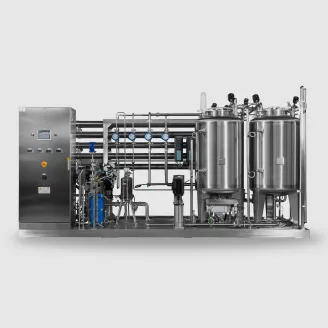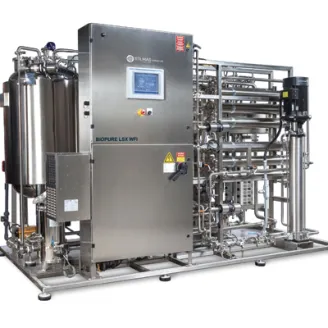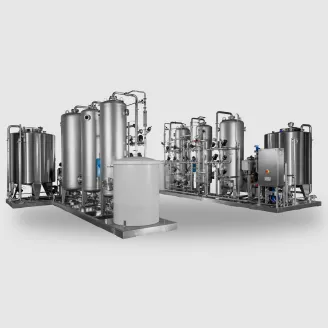Equipment
Reverse Osmosis + EDI
PHARMADION provides a reliable alternative to the traditional double pass Reverse Osmosis system for producing purified water from high conductivity feedwater

PHARMADION is an advanced and flexible platform based on a single-pass reverse osmosis and a CEDI stage. This system ensures extremely low conductivity, offering both flexibility and robustness, with a particular focus on sustainability issues. The plant is designed and built following the highest quality standards
PHARMADION can generate from 500 to 30.000 lt/h of PW, with self-modulating valves allowing the user to dial in required flowrates.
Technical description
Operating principle
Softened feed water is pre-filled into a break tank. A circulation pump and a high-pressure pump feed the first stage of membranes, with the number of membranes determining the processing capacity. The osmosed water produced enters the second stage of membranes, while the concentrate is rejected. The pure water produced is then sent to storage, and the second stage concentrate is recovered to the break tank for consumption optimisation. The tank, pumps, and filter of the first stage are also used for chemical washing and sanitising the membranes. Stilmas’ exclusive plant configuration ensures best performance and operation flexibility by allowing periodical recirculation during stand-by conditions to control bacterial contamination.
Electrodeionisation
CDI (Continuous Deionisation) technology operates by generating an electrical field within the water stream, separating positive and negative ions, which are then captured by ion exchange resins within the system. The captured salt ions are subsequently released into a small stream of water (concentrate) and recycled back into the feed water tank. CDI technology also allows for continuous regeneration of the resins, thereby avoiding contact of the CDI modules with external and potentially contaminated water streams
Sanitisation process
This system can be sanitised using chemical sanitisation (standard version) or through heating (upon request). Chemical sanitisation involves circulating a low-concentration H2O2 solution, which is a non-dangerous chemical and can be easily removed from the process (H2O2 naturally converts into H2O). Alternatively, upon request, the plants can be equipped with a steam-heated exchanger, as well as membranes and EDI modules suitable for hot water circulation.


